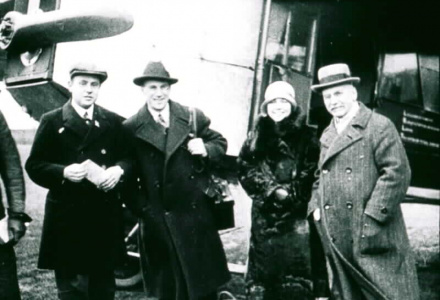KLM: National Pride
On 1 October 1924, the Fokker F.VII took off for the Dutch East Indies with two pilots, Van der Hoop and Van Weerden Poelman, as well as a flight engineer, Van den Broeke, on board. After a month-long stopover in Plovdiv, Bulgaria, due to mechanical problems, the plane arrived on 24 November 1924 at 1:30 am. This flight opened the air routes to the Dutch East Indies and substantially reduced travel time to the colony. Despite this, it would be five more years before the first passenger flights to the East would take place.
Enthusiasm and pride
The Fokker F.VII flight to the East Indies generated a lot of enthusiasm in both the Netherlands and the Netherlands East Indies. The newspapers were full of reports and articles, and the other media picked up their end as well, including film. The preparations and departure were filmed by many companies and the adventurous camera operator Henk Alsem even travelled to Bulgaria to film the stranded aviators.
Pictures from their landing in the Dutch East Indies and the celebration upon the crew’s return show that there was tremendous interest in these events. The aviators were treated like heroes – but that was in the days when aviation was prestigious and major achievements led to a sense of national pride.
Animation for the aviation exhibition
Aviation developed rapidly during WWI. Techniques were improved and aviation’s potential was explored. This resulted in aviation becoming a promising new form of shipping and transport after the war. This promise held by aviation was showcased at the Eerste Luchtverkeer Tentoonstelling Amsterdam (ELTA) that took place in August and September 1919 in Amsterdam. People gasped in admiration at the newest models by domestic and foreign aircraft builders, there were flying demonstrations by well-known aviators and visitors could even go for a round trip over Amsterdam. The exhibition drew a half a million visitors.
A short animated film was used to advertise the ELTA. Een avontuurtje in ’t luchtruim by Alex Benno and George Debels The film is one of the earliest Dutch animations. These weren’t the ELTA’s only films in the cinema. The newsreels showed films of the exhibition’s opening, the queen visiting the event, and ELTA’s homage to the British Captain Alcock.
Filming heroic endeavours
Aviation was always popular in the cinemas. National civilian aviation was a source of national pride and film had an important role to play in the corresponding propaganda race. Heroic flights such as the first non-stop transatlantic flight by the British aviators Alcock and Brown in June 1919 were shown in the cinemas, as was the first flight from England to Australia, made in that same year by the brothers Keith and Ross Macpherson Smith. There were also films on the Dutch aviation pioneers Anthonie Fokker and Frits Koolhoven. Both of them had his own aircraft factory.
The Fokker F.VII flight to the East Indies fit completely in this ‘tradition’, as did the flights to the East Indies and Melbourne in 1933-1934 with the Pelikaan and the Uiver. These were journeys made with aircraft from KLM (Koninklijke Luchtvaart Maatschappij; ‘Royal Aviation Company for the Netherlands and Colonies’), which was founded in October 1919.
Under the impassioned leadership by director Albert Plesman, KLM developed into a company of national importance. This reputation was reflected in the many filmed images, be they advertisements, informative films or news events.
more information
If you are looking for more material from our collection, please contact
Ms. Leenke Ripmeester
sales@eyefilm.nl
phone +31 (0)20 5891 426
mobile +31 (0)6 4118 9635
